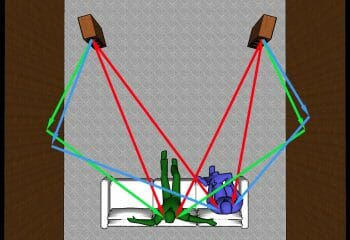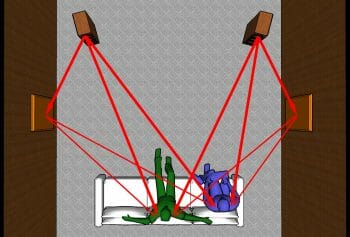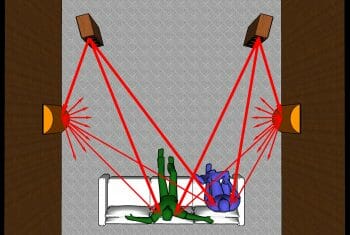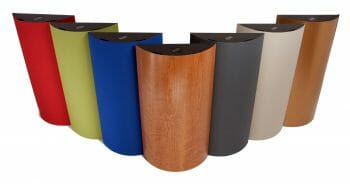What is Sound Diffusion (and Absorption)?
Here’s an easy definition: diffusion is the method of spreading out sound energy with a diffusor (diffuser) for better sound in a space. However, in the wide, wide world of acoustics, the sound diffusion process and tools are widely misunderstood, even by some acoustics professionals. This seems a bit odd, because it’s one of only two tools in our “Better Sounding Room” toolbox.
That’s right – there are only two acoustical tools available to improve sound inside a room, whether that room is huge or tiny: sound absorption and sound diffusion. Both tools will improve sound perception in spaces that, if left untreated, would be a bad influence on sound. In large acoustically-designed spaces, like concert halls, diffusion is most often built into the room’s physical geometry – the shapes of walls and ceilings (floors are nearly always flat and act as large flat-surface reflectors, even if sloped).
Keep in mind that absorption and diffusion are NOT the same as the methods used to reduce sound leakage into and out of a room, usually called “soundproofing,” which results in “less noise” (noise defined as any unwanted sound). Absorption and diffusion are called room treatments and are used for “better sound”.
Why would we need better sound in rooms? Because most walls, floors, and ceilings are made up of hard, flat surfaces which strongly reflect sound energy intact. These strong, intact reflections cause problems when they’re-combine with the original sound, which arrives at our ears directly through air without reflecting. Because the reflections are traveling farther, they are delayed compared to the original sound (see Fig. 1).
Multiple delays from many flat surfaces, combined with original sound, add too much echo and reverberation. Equally problematic, delays from sound reflections cause timing (or “phase”) errors – these disrupt sound-stage imaging and cause frequency additions and subtractions called “comb-filtering” (from the shape of the resulting frequency-response peaks and dips). Accurately hearing original sound, whether from voices, musical instruments, or loudspeakers, becomes difficult. Too much intact reflected sound energy causes sound in rooms to become unwanted, uncomfortable, and unavoidable noise.

Figure 1 – Original sound: red lines; reflected sound: blue and green lines
Because absorption is the one process many people think of when referring to acoustical treatments, let’s look at an easy definition of sound (acoustic) absorption before looking at diffusion: acoustic absorption is the process of reducing sound energy (see Fig. 2), as opposed to reflecting sound energy. The absorbed sound energy is not equal across all frequencies, however, usually causing a shift in tonal perception, with higher frequencies the most easily absorbed. Most often, an absorptive panel of fibrous material (fiberglass, cotton, mineral wool, wood wool) is placed in a room on hard, flat sound-reflective surfaces to reduce the energy “bounced” back into the room.

Figure 2 – sound reflection energy reduced with absorber panels
Manufacturers of acoustic fiberglass panels often tout them as the only solution, and in some situations, like gymnasiums, restaurants, and churches, absorber panels may be the only room treatments needed. Additionally, these panels are economical and widely distributed. In practice, though, it is possible to have too many absorbers in a room, causing a perceptual disconnect between mental expectation of what the sound in the room will be like and an “overdamped” acoustic reality. Overly-absorbent room treatments can cause their own set of problems in some spaces.
A balance of absorption and diffusion is better for critical-listening rooms. Adding diffusion (see Fig. 3) keeps enough energy in the room to sound more natural while spreading out some of the reflected energy. Additionally, diffusion can give the impression of a larger space, which is good for smaller listening rooms. More well-trained listeners – such as recording engineers and audiophiles – usually aim for a 50% mix of absorption and diffusion.

Figure 3 – curved-surface diffusor panels evenly spread sound energy
As mentioned earlier, many people think absorption is the only available room treatment. Likewise, some people think there is only one type of diffusion product – the Quadratic-Residue Diffusor (QRD). QRD treatments rely on shifting the timing, or phase, of the reflected sound to spread the energy. They are most often used on the back wall of listening and control rooms, because the phase-disrupted reflections exhibit lobing (uneven frequency distribution) and create sound-stage imaging problems when used in first-reflections points on the side and front walls. Pyramid- and cube-shaped reflectors are also used as diffusion elements, but these types of reflectors are best used at a farther distance from listeners than curved or spherical diffusors due to their flat reflective surfaces.
Which brings us to geometric shapes used as diffusors. The two best diffusor geometries are “slices” or sections of cylindrical and spherical shapes, because they evenly spread sound energy within a space. Additional benefits of these shapes are that the spread-out reflections are broadband, affecting a wide frequency range, and the evenly-reflected sound is phase-coherent, meaning the timing signatures contained in the original sound are preserved as much as possible. Cylindrical and spherical shapes have a constant radius, ensuring the sound is spread consistently regardless of the incident angle (the direction of incoming sound waves). Sphere shapes diffuse in two dimensions (height and width), where cylinder shapes diffuse in either width or height, depending on orientation.
Diffusion is now gaining wider acceptance as an extremely useful and natural-sounding option for helping problem rooms sound much better. Affordable cylindrical diffusors are being produced from curved aluminum, offering a wide array of finish colors and styles, by incorporating fabric, automotive paints, and wood veneers (see Fig. 4). Placed on walls and ceilings at first-reflection points in listening and recording rooms, phase-coherent cylindrical sections really improve the sound – and décor – in nearly any shape of room or space imaginable.

Figure 4 – curved-surface diffusor finish options



